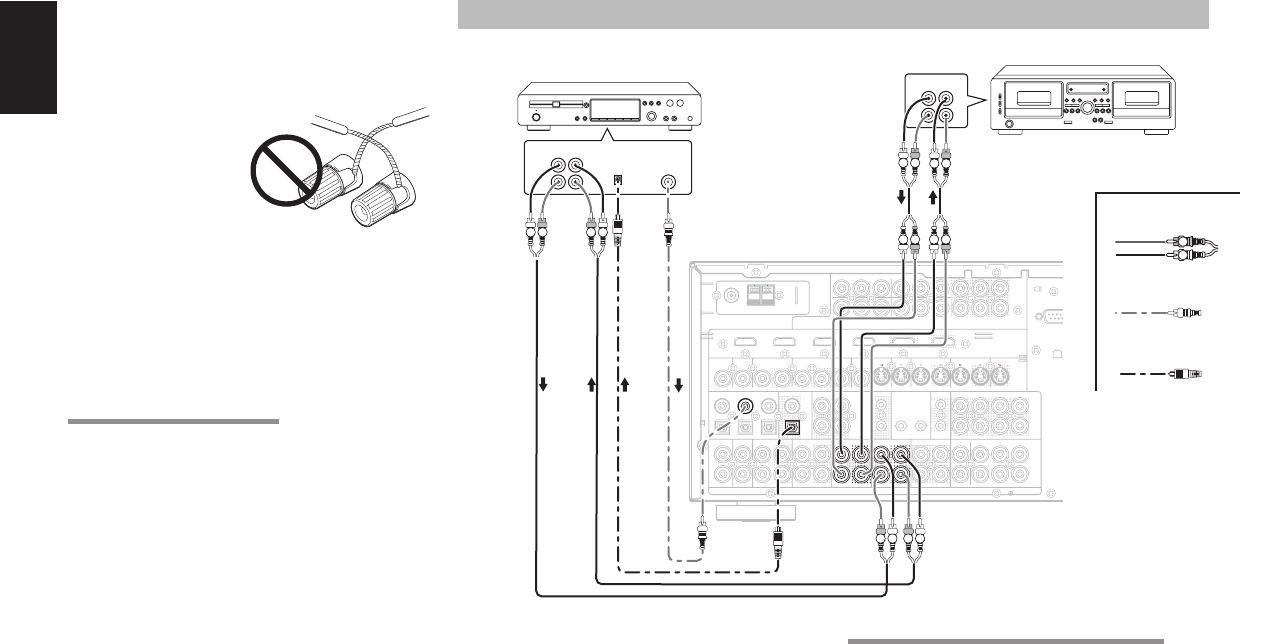
ENGLISH
14
Caution:
•
Be sure to use speakers with the specifi ed impedance as
shown on the rear panel of this unit.
•
To prevent damage to circuitry, do not let the bare
speaker wires touch each other and do not let them
touch any metal part
of this unit.
• Do not touch the
speaker terminals
when the power is
on. It may cause
you to receive an
electric shocks.
• Do not connect more than one speaker cable to one
speaker terminal. Doing so may damage this unit.
Note:
•
Be sure to connect the positive and negative cables for
the speaker properly. If they are miss-connected, the
signal phase will be reversed and the signal quality will
be corrupted.
CONNECTING A SUBWOOFER
Use the PRE OUT SUBWOOFER jack to connect a
powered subwoofer (power amplifi er built in ).
If your subwoofer is a passive type (power amplifi er
is not built in), connect a monaural power amplifi er to
the PRE OUT SUBWOOFER jack and connect the
subwoofer to the amplifi er.
CONNECTING AUDIO COMPONENTS
OUT
OUT
TAPE
TAPE
CD/CDR
CD/CDR
OUT
OUT
IN
IN
IN
IN
5
5
DIGITAL IN
DIGITAL IN
COMPONENT
VIDEO
IN OUT
S-VIDEO
IN OUT
2
1
SLL
RSR
FLASHER
IN
IR
RECEIVER
IN
OUT
6
COAX.
3
4
21
OUT
R
LMULTI OUT
R
OUT
L
DSS/VCR2
AUDIO
AUDIO
TV
IN
OPT.
IN
OUT
INOUT
IN
SR
VCR1
IN
DVD SL
C
B
/
P
B
C
R
/
P
R
C
R
/
P
R
C
R
/
P
R
C
B
/
P
B
C
B
/
P
B
YYY
SBR
SBL
SBR
SBL
C
SW
SW
C
1
2
EMITTER
OUT
AB
VIDEO
FM
(
75Ω
)
GND AM
ANTENNA
OUT
PUT
1
OUT
PUT
2
INPUT 3
(
VCR1
)
OUTPUT 1 OUTPUT 2INPUT 1
(
TV
)
INPUT 1
(
TV
)
INPUT 4
(
DSS/VCR2
)
INPUT 3
(
VCR1
)
INPUT 4
(
DSS/VCR2
)
INPUT 2
(
DVD
)
HDMI
Ver1.2
INPUT 2
(
DVD
)
DC OUT
PRE
OUT
DIGITAL OUTDIGITAL OUT
DIGITAL OUT
RC-5MULTI RC
7.1CH
IN
MONITOR
OUT
DVD
(
2
)
DSS/VCR2
(
4
)
TV
(
1
)
MULTI
OUT
VCR1
(
3
)
DVD
(
2
)
DSS/VCR2
(
4
)
VCR1
(
3
)
TV
(
1
)
MONI. OUT
(
AUX2
)
XM
RS-23
2
XM
OUT IN
L
R
L
R
DIGITAL
INPUT
DIGITAL
OUTPUT
OUT IN
L
R
L
R
L R
L R
RL RL
R L
R L R L
RL
L R
The output audio signal from the TAPE OUT jack and
the CD/CD RECORDER OUT jack is the same signal
which is currently selected.
Caution:
• Do not connect this unit and other components
to mains power until all connections between
components have been completed.
Notes:
• Insert all plugs and connectors securely. Incomplete
connections may make noise.
• Be sure to connect the left and right channels
properly.
Red connectors are for the R (right) channel, and
white connectors are for the L (left) channel.
• Be sure to connect input and output properly.
• Refer to the instructions for each component that is
connected to this unit.
• Do not bind audio/video connection cables with
power cords and speaker cables this will result in
generating a hum or other noise.
CONNECTING DIGITAL AUDIO COMPONENTS
• There are 6 digital inputs, 3 coaxial jacks and
3 optical jacks, on the rear panel. You can use
these jacks to input PCM, Dolby Digital and DTS
bitstream signals from a CD, DVD, or other digital
source components.
• There is one digital output coaxial jack and one
optical output jack on the rear panel. These jacks
can be connected to a CD recorder-, or a MD deck
inputs, respectively.
• Refer to the instructions for each component. To
setup the digital audio format of DVD player, or
other digital source’s connected to digital input
jacks.
• Use fi ber optical cables (optical) for DIG-1,2,3
input jacks. Use 75 ohms coaxial cables (for
digital audio or video) for DIG-4, 5, 6 input jacks.
• You can designate the input for each digital input/
output jacks according to your component. See
page 25.
CD recorder / MD deck
Tape Deck
Analog Audio
Digital Audio (coaxial)
Digital Audio (optical)
Notes:
• There is no Dolby Digital RF input jack. Use an
external RF demodulator Dolby Digital decoder
when connecting the Dolby Digital RF output jack
of the videodisc player to the digital input jack.
• The digital signal jacks on the SR7001 conform
to the EIA standard. If you use a cable that does
not conform to this standard, the SR7001 may not
function properly.
• Each type of audio jack works independently.
Signals input through the digital and analog jacks are
output through the corresponding digital and analog
jacks, respectively.


















